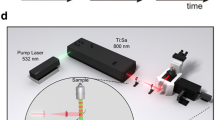Abstract
There is considerable interest in understanding the interactions of antimicrobial peptides with phospholipid membranes. Fluorescence correlation spectroscopy (FCS) is a powerful experimental technique that can be used to gain insight into these interactions. Specifically, FCS can be used to quantify leakage of fluorescent molecules of different sizes from large unilamellar lipid vesicles, thereby providing a tool for estimating the size of peptide-induced membrane disruptions. If fluorescently labeled lipids are incorporated into the membranes of the vesicles, FCS can also be used to obtain information about whether leakage occurs due to localized membrane perturbations or global membrane destabilization. Here, we outline a detailed step-by-step protocol on how to optimally implement an FCS-based leakage assay. To make the protocol easily accessible to other researchers, it has been supplemented with a number of practical tips and tricks.
The original version of this chapter was revised. The erratum to this chapter is available at: DOI 10.1007/978-1-4939-6737-7_32
An erratum to this chapter can be found at http://dx.doi.org/10.1007/978-1-4939-6737-7_32
Access this chapter
Tax calculation will be finalised at checkout
Purchases are for personal use only
Similar content being viewed by others
References
Wimley WC, Hristova K (2011) Antimicrobial peptides: successes, challenges and unanswered questions. J Membr Biol 239:27–34
Almeida PF (2014) Membrane-active peptides: binding, translocation, and flux in lipid vesicles. Biochim Biophys Acta 1838:2216–2227
Allen TM, Cleland LG (1980) Serum-induced leakage of liposome contents. Biochim Biophys Acta 597:418–426
Weinstein JN, Yoshikami S, Henkart P et al (1977) Liposome-cell interaction: transfer and intracellular release of a trapped fluorescent marker. Science 195:489–492
Matsuzaki K, Murase O, Miyajima K (1995) Kinetics of pore formation by an antimicrobial peptide, magainin 2, in phospholipid bilayers. Biochemistry 34:12553–12559
Ladokhin AS, Wimley WC, White SH (1995) Leakage of membrane vesicle contents: determination of mechanism using fluorescence requenching. Biophys J 69:1964–1971
Wimley WC (2015) Determining the effects of membrane-interacting peptides on membrane integrity. Methods Mol Biol 1324:89–106
Patel H, Tscheka C, Heerklotz H (2009) Characterizing vesicle leakage by fluorescence lifetime measurements. Soft Matter 5:2849–2851
Pramanik A, Thyberg P, Rigler R (2000) Molecular interactions of peptides with phospholipid vesicle membranes as studied by fluorescence correlation spectroscopy. Chem Phys Lipids 104:35–47
Magzoub M, Oglęcka K, Pramanik A et al (2005) Membrane perturbation effects of peptides derived from the N-termini of unprocessed prion proteins. Biochim Biophys Acta 1716:126–136
Yu L, Guo L, Ding JL et al (2009) Interaction of an artificial antimicrobial peptide with lipid membranes. Biochim Biophys Acta 1788:333–344
Blicher A, Wodzinska K, Fidorra M et al (2009) The temperature dependence of lipid membrane permeability, its quantized nature, and the influence of anesthetics. Biophys J 96:4581–4591
Macháň R, Jurkiewicz P, Olżyńska A et al (2014) Peripheral and integral membrane binding of peptides characterized by time-dependent fluorescence shifts: focus on antimicrobial peptide LAH4. Langmuir 30:6171–6179
Kristensen K, Henriksen JR, Andresen TL (2014) Quantification of leakage from large unilamellar lipid vesicles by fluorescence correlation spectroscopy. Biochim Biophys Acta 1838:2994–3002
Kristensen K, Ehrlich N, Henriksen JR, Andresen TL (2015) Single-vesicle detection and analysis of peptide-induced membrane permeabilization. Langmuir 31:2472–2483
Krichevsky O, Bonnet G (2002) Fluorescence correlation spectroscopy: the technique and its applications. Rep Prog Phys 65:251–297
Ries J, Schwille P (2012) Fluorescence correlation spectroscopy. Bioessays 34:361–368
Henriksen JR, Andresen TL (2011) Thermodynamic profiling of peptide membrane interactions by isothermal titration calorimetry: a search for pores and micelles. Biophys J 101:100–109
Rouser G, Siakotos AN, Fleischer S (1966) Quantitative analysis of phospholipids by thin-layer chromatography and phosphorus analysis of spots. Lipids 1:85–86
Kim SA, Heinze KG, Schwille P (2007) Fluorescence correlation spectroscopy in living cells. Nat Methods 4:963–973
Enderlein J, Gregor I, Patra D et al (2005) Performance of fluorescence correlation spectroscopy for measuring diffusion and concentration. ChemPhysChem 6:2324–2326
Hess ST, Webb WW (2002) Focal volume optics and experimental artifacts in confocal fluorescence correlation spectroscopy. Biophys J 83:2300–2317
Bartlett GR (1959) Phosphorus assay in column chromatography. J Biol Chem 234:466–468
Stewart JC (1980) Colorimetric determination of phospholipids with ammonium ferrothiocyanate. Anal Biochem 104:10–14
Kristensen K, Henriksen JR, Andresen TL (2015) Adsorption of cationic peptides to solid surfaces of glass and plastic. PLoS One 10:e0122419
Gill SC, von Hippel PH (1989) Calculation of protein extinction coefficients from amino acid sequence data. Anal Biochem 182:319–326
Wohland T, Rigler R, Vogel H (2001) The standard deviation in fluorescence correlation spectroscopy. Biophys J 80:2987–2999
Melo AM, Prieto M, Coutinho A (2014) Quantifying lipid-protein interaction by fluorescence correlation spectroscopy (FCS). Methods Mol Biol 1076:575–595
Sahoo B, Drombosky KW, Wetzel R (2016) Fluorescence correlation spectroscopy: a tool to study protein oligomerization and aggregation in vitro and in vivo. Methods Mol Biol 1345:67–87
Rüttinger S, Buschmann V, Krämer B et al (2008) Comparison and accuracy of methods to determine the confocal volume for quantitative fluorescence correlation spectroscopy. J Microsc 232:343–352
Bohrer MP, Deen WM, Robertson CR et al (1979) Influence of molecular configuration on the passage of macromolecules across glomerular capillary wall. J Gen Physiol 74:583–593
Acknowledgments
We thank Jannik B. Larsen and Anncatrine L. Petersen for critical reading of the manuscript and valuable comments. Financial support for this work was kindly provided by the NanoMorph consortium—funded by the Danish Council for Technology and Innovation—and the Lundbeck Foundation Research Initiative on Brain Barriers and Drug Delivery.
Author information
Authors and Affiliations
Corresponding author
Editor information
Editors and Affiliations
Rights and permissions
Copyright information
© 2017 Springer Science+Business Media LLC
About this protocol
Cite this protocol
Kristensen, K., Henriksen, J.R., Andresen, T.L. (2017). Applying Fluorescence Correlation Spectroscopy to Investigate Peptide-Induced Membrane Disruption. In: Hansen, P. (eds) Antimicrobial Peptides. Methods in Molecular Biology, vol 1548. Humana Press, New York, NY. https://doi.org/10.1007/978-1-4939-6737-7_11
Download citation
DOI: https://doi.org/10.1007/978-1-4939-6737-7_11
Published:
Publisher Name: Humana Press, New York, NY
Print ISBN: 978-1-4939-6735-3
Online ISBN: 978-1-4939-6737-7
eBook Packages: Springer Protocols




